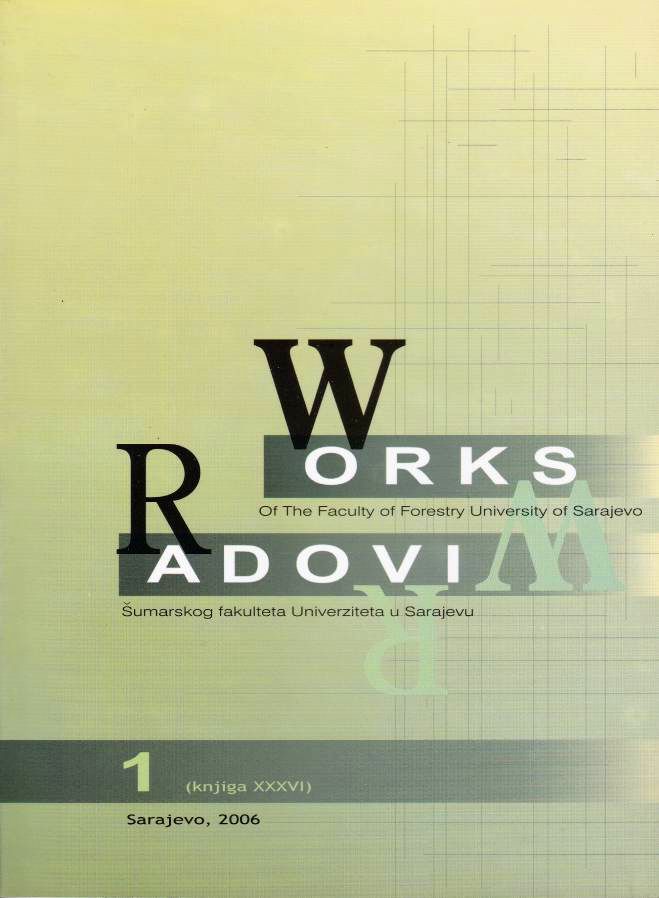Spruce in Bosnia and Herzegovina
DOI:
https://doi.org/10.54652/rsf.2006.v36.i1.191Keywords:
Picea abies, isoenzyme, populations, variabilityAbstract
UDK 582.475:577.151.64(497.6)
Spruce (Picea abies Karst.) represents one of the most significant species of forest trees in Bosnia and Herzegovina and in a number of central European countries, from both economic and ecological stand point. The objective of this study is to demonstrate basic molecular-genetic variability of spruce in Bosnia and Herzegovina in order to determine their mutual relationship and origin. For the analysis of isoenzyme genetic structures we used the following isoenzyme genetic markers: Aco- A, F-Est-B, Gdh-A, Got-A, Got-B, Got-C, Idh-A, Idh-B, Lap-B, Mdh-A, Mdh-B, Mdh-
C, Mnr–A, Mnr–C, Pgi-B, Pgm-A, Skdh-A, 6-Pgdh-A, 6-Pgdh-B, 6-Pgdh-C, 6-Pdh-A. From the obtained relative allele frequencies in the analyzed loci, it is verified that all of 20 analyzed gene loci were polymorphous, while an extremely high level of polymorphisms was registered in 15 loci. The population of Vlašić, by its genetic structure, shows that it is alochton, and that the reproduction material should not be used in any shape, until further detailed analyses have been carried out in this area. At the same time, spreading of unwanted gene-pool should be prevented with special management measures. More significant value of heterozygosis of the studied populations, as opposed to the population of west European spruce, shows that the studied populations did not loose much of their genetic adaptation potential as they are not situated far from their natural habitat. Future studies should be directed to other populations of spruce in Bosnia and Herzegovina, in order to determine the optimal number of units in the sample. Economic management activities should be constantly monitored to provide rejuvenation of spruce and direct these activities to maintenance of genetic diversity of the local populations. Also there should be carried out a sequence of trials with diverse provenance in order to further examine ecological and physiological characteristics of spruce.
References
BALLIAN, D. (2000): Kvaliteta sadnog materijala u rasadnicima Federacije BiH, Seminar: Sjemensko - rasadnička proizvodnja u BiH - Aktualno stanje i perspektive, Brčko, st 76-78.
BERGMANN, F., GREGORIUS, H. R., LARSEN, J. B., 1990: Levels of genetic variation in European silver fir (Abies alba Mill.) are they related to the species decline. Genetica, 82 (1): 1-10.
BOROJEVIĆ, K., 1985: Geni i populacija, Novi Sad, str. 545.
BOŽIČ, G., 2002:Genetske raziskave naravnih populacij smreke (Picea abies (L.) Karst.) v Sloveniji. Doktorska disertacija, Univ. v Ljubljani, BF, Odd. za gozdarstvo in obnovljive gozdne vire, 2002.
BOŽIČ, G., URBANČIČ, M. 2001: Influences of the soils on the morfological characteristics of an autochthonous Norway spruce on the Pokljuka plateau. Glas. Šum. Pokuse, 38: 137-147, Zagreb.
BOŽIČ, G., URBANČIČ, M. 2003: The morfological and genetical characterisation of native Norway spruce (Picea abies (L.) Karst.) population in the area of Pokljuka mire. Acta Biologica Slovenica. 46 (1):17-25, Ljubljana.
BOŽIČ, G., KONNERT, M., ZUPANČIČ, M., KRAIGHER, H., KREFT, I. 2003: Genetska diferencijacija avtohtonih populacij smreke (Picea abies (L.) Karst.) v Sloveniji, ugotovljena z analizo izoenzimov. Zbornik gozdarstava in lesarstva 71: 19-40.
CROW, J.F., KIMURA, M. 1970: Introduction to Population Genetics Theory, Harper and Row, New York.
GREGORIUS, H.R., 1980: The probability of losing an allele when diploid genotypes are sampled. Biometric, 36: 643-652.
GREGORIUS, H.R., 1983: Gregorius, H. R., 1983: Klonanzahl in Samenplantagen und genetische Vielfalt. Arbeitstagung Forum Genetik Wald Forstwirtschaft, Göttingen, 58-62.
HAMRICK, J.L., GODT, M.J., 1990: Allozyme diversity in plant species. In: Brown, A.D.D., Clegg, M.T., Kahler, A.L., Weir, B.S. (ed.): Plant Population Genetics. Breeding, and Genetic Resources, Sinauer, 43-63.
KONNERT, M. 2004: Handbücher für Isoenzymanalyse. www.genre.de/fgrdeu/blag/iso- handbuecher
KRAJMEROVA, D., LONGAUER, R. 2000: Genetic diversity of Norway spruce in Slovakia. Forest Journal 46(3): 273-286.LARSEN, J.B., 1986: Das Tannensterben: Eine neue Hypothese zur Klärung des Hintergrundes dieser rätselhaften Komplexkrankheit der Weißtanne (Abies alba Mill.), Fortwissenschaflitches Centralblatt, Gottingen, 105 (5): 381-396.
MATIĆ, V., DRINIĆ, P., STEFANOVIĆ, V., ČIRIĆ, M., i sur. 1971: Stanje šuma u SR Bosni i Hercegovini, prema inventuri na velikim površinama u 1964-1968 godini [Condition of Forests in Socialist Republic of Bosnia-Herzegovina, according to inventory at large areas in 1964-1968.]. Šum. fak. i inst. za šum. posebna izdanja br. 7, Sarajevo, Bosna i Hercegovina. 639 pp.
SILVERTOWN, J.W., DOUST, J.L., 1995: Introduction to plant population biology,Blackwell Science, Reprinted 1995, str 210.


















